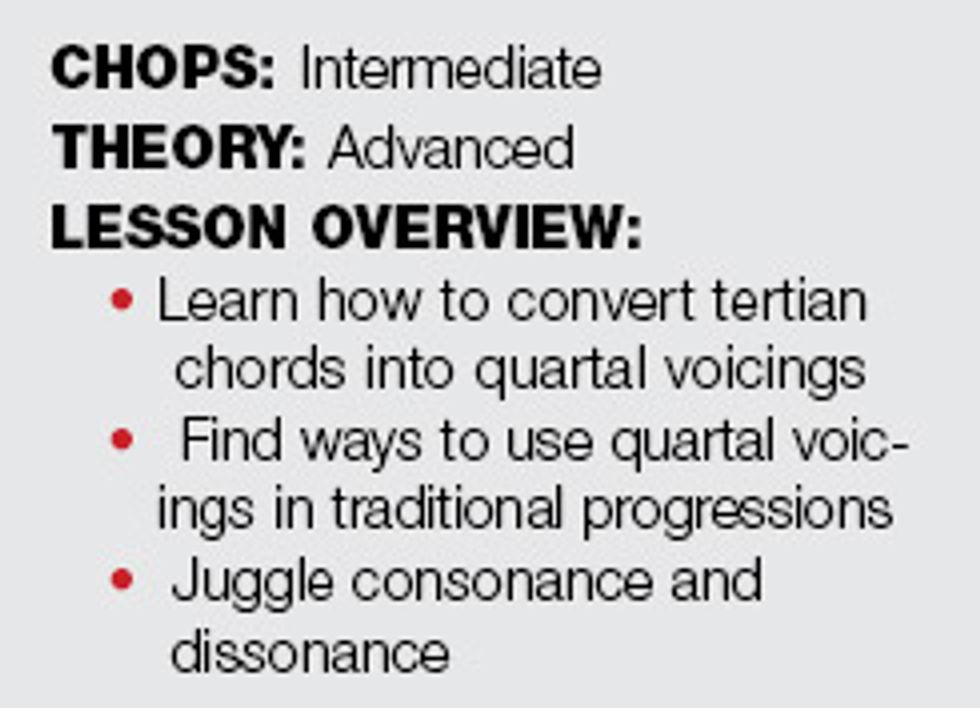For two months now, we’ve been investigating
quartal harmony and learning
how to use fourths as building blocks for
our chord voicings, rather than the traditional
thirds. We’ve looked at three-, four-,
and five-note quartal forms across various
string sets and test-driven more than a
dozen grips up and down the fretboard.
In this lesson, we’ll conclude our exploration by looking at ways to integrate quartal and tertian (third-based) harmony. If you missed the previous lessons or want to review the concepts we’ll be using in this month’s installment, visit premierguitar.com and look for “Exploring Quartal Harmony” and “Crazy Quartal Comping” in the April and May 2011 issues, respectively.
If you’ve played through the examples in the last two lessons, you know that quartal voicings have an edgy, restless sound. They’re neither major nor minor, and when played in a sequence, they don’t suggest the kinds of tension and resolution we’re used to hearing in, say, blues with its I-IV-V progressions or mainstream jazz with its ii-V-I cadences. Because of this, quartal voicings offer a degree of harmonic freedom, and they’re particularly handy when you want to accompany melodic improvisation without having to follow common chord patterns.
 But most music we hear consists of
thirds-based harmony and some combination
of major, minor, augmented,
diminished, and dominant chords. While
it’s fun to stack fourths, we can’t get
by as musicians on a strict quartal diet.
Wouldn’t it be great if we could bring
the ambiguous, angular sounds of quartal
voicings into the world of traditional tertian
harmony? Fortunately, we can.
But most music we hear consists of
thirds-based harmony and some combination
of major, minor, augmented,
diminished, and dominant chords. While
it’s fun to stack fourths, we can’t get
by as musicians on a strict quartal diet.
Wouldn’t it be great if we could bring
the ambiguous, angular sounds of quartal
voicings into the world of traditional tertian
harmony? Fortunately, we can.
And it’s simple—a visual thing. All we have to do is squint at a standard chord and see if we can imagine a quartal grip lurking in its shadow.
Let’s play a game: Can you create a quartal grip by changing just one note of a four-note tertian chord? That’s one note on one string—up or down a half-step or whole-step. If the other three chord tones remain the same, it stands to reason that in most musical contexts, you can substitute this spiky quartal doppelgänger for its more conventional sibling.
Fig. 1 shows ten voicings. The left column consists of standard chords we know and love, and the right column shows quartal grips that differ from their adjacent pals by only one note. For example, look at the top pair—E7 and E11. The first chord will be very familiar to most players. To get the second—which consists of two perfect fourths (E–A and A–D) topped by an augmented fourth (D–G#)—you simply drop E7’s B a whole-step to A.
Download Example Audio 1...
In our previous two lessons, we didn’t try to name the quartal forms we generated, simply because we’d left the world of traditional harmony—and its nomenclature— to explore a brave new realm where the old rules didn’t apply. But in this E11, we have a purely quartal voicing (E–A–D–G#) that we also can name and describe in conventional terms. Ah-ha! Sometimes quartal harmony can insinuate itself into the world of third-based chords.
Fig. 2 illustrates how easy it is to combine third- and fourth-based harmony, and how well these sounds blend. Essentially, we have an Em7-A progression—a ii-V in the key of D. But by changing Em7 to Em11, a one-note alteration, we inject a sense of mystery to the simple progression by having it begin with quartal harmony.
Download Example Audio 2...

Download Example Audio 3...

Of course, we’re not limited to minor substitutions. This “stealth” quartal technique of modifying tertian chords works well with dominant chords too—especially when you want a biting, funky riff, as in Fig. 4. Thanks to the tangy E11, we’ve put some attitude into what would be a bluesy, yet otherwise pretty tame I7-bVIIIV7 groove in the key of E. Again, one note makes all the difference between a ho-hum E7 and a whoa E11.
Download Example Audio 4...

So far in this lesson, we’ve been smuggling modified four-note seventh chords into our progressions. But three-note quartal clusters work well with tertian chords too, as shown in Fig. 5. If you look carefully at the B11, C#11, and E11 clusters in this example, you’ll see they’re simply stripped-down versions of the four-note E11 fingering shown in Fig. 1.
Download Example Audio 5...

To this point, the goal has been to demystify quartal harmony—what it is, how it sounds, and how it lies on the fretboard. From here, it’s simply a matter of finding ways to incorporate these bold colors into your own music.
Next month, we’ll look at another way to add pizzazz to progressions using something I call “sparkle” voicings. See you then.
 Andy Ellis is a veteran guitar journalist
and Senior Editor at PG. Based
in Nashville, Andy backs singer-songwriters
on the baritone guitar, and also
hosts The Guitar Show, a weekly on-air
and online broadcast. For the schedule,
links to the stations’ streams, archived audio
interviews with inspiring players, and more,
visit theguitarshow.com.
Andy Ellis is a veteran guitar journalist
and Senior Editor at PG. Based
in Nashville, Andy backs singer-songwriters
on the baritone guitar, and also
hosts The Guitar Show, a weekly on-air
and online broadcast. For the schedule,
links to the stations’ streams, archived audio
interviews with inspiring players, and more,
visit theguitarshow.com.
In this lesson, we’ll conclude our exploration by looking at ways to integrate quartal and tertian (third-based) harmony. If you missed the previous lessons or want to review the concepts we’ll be using in this month’s installment, visit premierguitar.com and look for “Exploring Quartal Harmony” and “Crazy Quartal Comping” in the April and May 2011 issues, respectively.
If you’ve played through the examples in the last two lessons, you know that quartal voicings have an edgy, restless sound. They’re neither major nor minor, and when played in a sequence, they don’t suggest the kinds of tension and resolution we’re used to hearing in, say, blues with its I-IV-V progressions or mainstream jazz with its ii-V-I cadences. Because of this, quartal voicings offer a degree of harmonic freedom, and they’re particularly handy when you want to accompany melodic improvisation without having to follow common chord patterns.
 But most music we hear consists of
thirds-based harmony and some combination
of major, minor, augmented,
diminished, and dominant chords. While
it’s fun to stack fourths, we can’t get
by as musicians on a strict quartal diet.
Wouldn’t it be great if we could bring
the ambiguous, angular sounds of quartal
voicings into the world of traditional tertian
harmony? Fortunately, we can.
But most music we hear consists of
thirds-based harmony and some combination
of major, minor, augmented,
diminished, and dominant chords. While
it’s fun to stack fourths, we can’t get
by as musicians on a strict quartal diet.
Wouldn’t it be great if we could bring
the ambiguous, angular sounds of quartal
voicings into the world of traditional tertian
harmony? Fortunately, we can.And it’s simple—a visual thing. All we have to do is squint at a standard chord and see if we can imagine a quartal grip lurking in its shadow.
Let’s play a game: Can you create a quartal grip by changing just one note of a four-note tertian chord? That’s one note on one string—up or down a half-step or whole-step. If the other three chord tones remain the same, it stands to reason that in most musical contexts, you can substitute this spiky quartal doppelgänger for its more conventional sibling.
Fig. 1 shows ten voicings. The left column consists of standard chords we know and love, and the right column shows quartal grips that differ from their adjacent pals by only one note. For example, look at the top pair—E7 and E11. The first chord will be very familiar to most players. To get the second—which consists of two perfect fourths (E–A and A–D) topped by an augmented fourth (D–G#)—you simply drop E7’s B a whole-step to A.
Download Example Audio 1...
In our previous two lessons, we didn’t try to name the quartal forms we generated, simply because we’d left the world of traditional harmony—and its nomenclature— to explore a brave new realm where the old rules didn’t apply. But in this E11, we have a purely quartal voicing (E–A–D–G#) that we also can name and describe in conventional terms. Ah-ha! Sometimes quartal harmony can insinuate itself into the world of third-based chords.
Fig. 2 illustrates how easy it is to combine third- and fourth-based harmony, and how well these sounds blend. Essentially, we have an Em7-A progression—a ii-V in the key of D. But by changing Em7 to Em11, a one-note alteration, we inject a sense of mystery to the simple progression by having it begin with quartal harmony.
Download Example Audio 2...

Download Example Audio 3...

Of course, we’re not limited to minor substitutions. This “stealth” quartal technique of modifying tertian chords works well with dominant chords too—especially when you want a biting, funky riff, as in Fig. 4. Thanks to the tangy E11, we’ve put some attitude into what would be a bluesy, yet otherwise pretty tame I7-bVIIIV7 groove in the key of E. Again, one note makes all the difference between a ho-hum E7 and a whoa E11.
Download Example Audio 4...

So far in this lesson, we’ve been smuggling modified four-note seventh chords into our progressions. But three-note quartal clusters work well with tertian chords too, as shown in Fig. 5. If you look carefully at the B11, C#11, and E11 clusters in this example, you’ll see they’re simply stripped-down versions of the four-note E11 fingering shown in Fig. 1.
Download Example Audio 5...

To this point, the goal has been to demystify quartal harmony—what it is, how it sounds, and how it lies on the fretboard. From here, it’s simply a matter of finding ways to incorporate these bold colors into your own music.
Next month, we’ll look at another way to add pizzazz to progressions using something I call “sparkle” voicings. See you then.
 Andy Ellis is a veteran guitar journalist
and Senior Editor at PG. Based
in Nashville, Andy backs singer-songwriters
on the baritone guitar, and also
hosts The Guitar Show, a weekly on-air
and online broadcast. For the schedule,
links to the stations’ streams, archived audio
interviews with inspiring players, and more,
visit theguitarshow.com.
Andy Ellis is a veteran guitar journalist
and Senior Editor at PG. Based
in Nashville, Andy backs singer-songwriters
on the baritone guitar, and also
hosts The Guitar Show, a weekly on-air
and online broadcast. For the schedule,
links to the stations’ streams, archived audio
interviews with inspiring players, and more,
visit theguitarshow.com.












![Rig Rundown: Russian Circles’ Mike Sullivan [2025]](https://www.premierguitar.com/media-library/youtube.jpg?id=62303631&width=1245&height=700&quality=70&coordinates=0%2C0%2C0%2C0)













